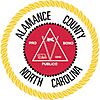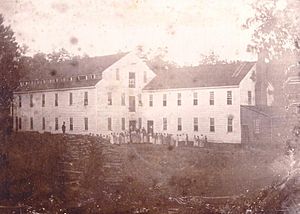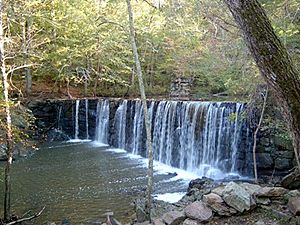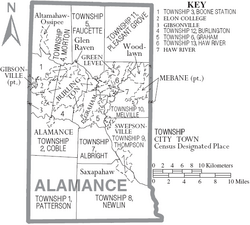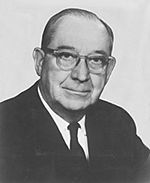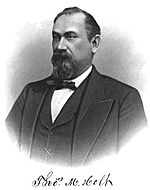Alamance County, North Carolina facts for kids
Quick facts for kids
Alamance County
|
|||
|---|---|---|---|
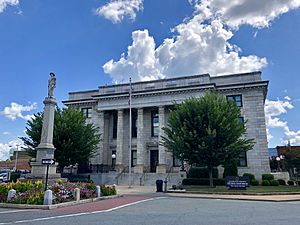
|
|||
|
|||
| Motto(s): | |||
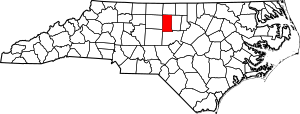
Location within the U.S. state of North Carolina
|
|||
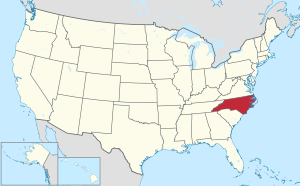 North Carolina's location within the U.S. |
|||
| Country | |||
| State | |||
| Founded | 1849 | ||
| Named for | Native American word to describe the mud in Great Alamance Creek | ||
| Seat | Graham | ||
| Largest community | Burlington | ||
| Area | |||
| • Total | 434.24 sq mi (1,124.7 km2) | ||
| • Land | 423.45 sq mi (1,096.7 km2) | ||
| • Water | 10.79 sq mi (27.9 km2) 2.48% | ||
| Population
(2020)
|
|||
| • Total | 171,415 | ||
| • Estimate
(2023)
|
179,165 |
||
| • Density | 394.747/sq mi (152.4127/km2) | ||
| Time zone | UTC−5 (Eastern) | ||
| • Summer (DST) | UTC−4 (EDT) | ||
| Congressional district | 4th | ||
Alamance County (![]() i/ˈæləmæns/) is a county in North Carolina. As of the 2020 census, about 171,415 people live here. Its county seat (the main town for government) is Graham. Alamance County was created in 1849 from Orange County. It has been important for its history, making textiles, and farming.
i/ˈæləmæns/) is a county in North Carolina. As of the 2020 census, about 171,415 people live here. Its county seat (the main town for government) is Graham. Alamance County was created in 1849 from Orange County. It has been important for its history, making textiles, and farming.
Alamance County is part of the Burlington, NC Metropolitan Area. This area is also part of a larger region called the Piedmont Triad, which includes Greensboro, Winston-Salem, and High Point. In 2023, this larger area had an estimated population of over 1.7 million people.
Contents
History of Alamance County
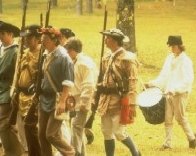
Before Alamance County was formed, a small Native American tribe called the Sissipahaw lived here in the 1700s. They lived near modern Saxapahaw and the Haw River. European settlers arrived in the late 1600s, following Native American trading paths. They farmed the fertile land that the Sissipahaw had used. These old paths later became routes for railroads and highways.
Alamance County got its name from Great Alamance Creek. This creek was the site of the Battle of Alamance on May 16, 1771. This was a battle before the American Revolution, where Governor William Tryon's militia defeated the Regulator movement. Legends say the creek was named for a Native American word describing the blue mud at the bottom. Other stories suggest it meant "noisy river" or came from the Alamanni region in Germany, where many early settlers came from.
During the American Revolution, several small fights happened in the area. These included Pyle's Massacre, the Battle of Lindley's Mill, and the Battle of Clapp's Mill. These events led up to the larger Battle of Guilford Court House.
In the 1780s, the Occaneechi Native Americans returned to North Carolina and settled in what is now Alamance County. In 2002, the modern Occaneechi tribe bought 25 acres (10 ha) of their old land. They started a project to preserve their homeland, including a reconstructed village from 1701.
In the early 1800s, the textile industry grew a lot in the area. Many mills were built along the Haw River and other creeks. Between 1832 and 1880, at least 14 large mills used the power of these rivers. One mill, built in 1832 by Ben Trollinger, is still working today. It is the oldest continuously operating mill in North Carolina.
A famous fabric made here was "Alamance Plaids." These were the first colored cotton goods made on power looms in the South. This invention by Edwin M. Holt helped the region's textile industry boom. However, by the late 1900s, most of these mills closed down.
By the 1840s, the textile industry was thriving, and a railroad was being built. This railroad connected Raleigh and Greensboro. Alamance County was officially formed on January 29, 1849, from Orange County.
Civil War in Alamance County
In March 1861, most Alamance County residents voted against North Carolina leaving the Union. However, after the Battle of Fort Sumter in April 1861, things changed. When President Lincoln asked for troops, North Carolina's governor refused. The state's legislature then voted to leave the Union on May 20, 1861.
No major battles happened in Alamance County during the war. However, the county sent many soldiers to fight. In July 1861, soldiers from Alamance County were sent to the battlefront by train for the first time in American history. They went to the First Battle of Manassas in Virginia.
In April 1865, just before the war ended, soldiers marched through the county. General Joseph E. Johnston said goodbye to his soldiers in Company Shops (now Burlington). By the end of the war, 236 people from Alamance County had died. This was more than in any other war since the county was founded.
After the Civil War
After the Civil War, Alamance County became known for a sad event. In 1870, Wyatt Outlaw, an African American Town Commissioner in Graham, was killed. He was a leader who worked to establish the Republican party and wanted a school for African Americans. He was found hanging near the courthouse. A note on his chest warned others.
This event led to Governor Holden sending troops to the area. Many men were arrested. However, a new law was passed that dropped the charges against those involved. There was no justice for Wyatt Outlaw's murder. Governor William Holden was later removed from his position in 1871 because of his support for Reconstruction.
Other Industries and Events
Alamance County was once a leader in dairy farming in North Carolina. Many dairy farms were here, but most have been sold due to rising land prices and lower milk prices.
During World War II, Fairchild Aircraft built planes in Burlington. These included the AT-21 gunner, used to train bomber pilots. Nearby, Western Electric built radar and missile guidance systems during the Cold War. The guidance system for the Titan missile was made there. This plant closed in 1992.
The USS Alamance, a Navy ship, was built during and after World War II.
Alamance County has been home to several important politicians. Three of North Carolina's governors and two U. S. senators came from here. These include Governor Thomas Holt, Governor and Senator Kerr Scott, Governor Robert W. (Bob) Scott, and Senator B. Everett Jordan.
Geography of Alamance County
The U.S. Census Bureau says the county covers about 435 square miles (1,127 km2). About 424 square miles (1,098 km2) is land, and 11 square miles (28 km2) is water.
The county is in the Piedmont region, which has rolling hills. The Cane Creek Mountains rise to over 970 feet (300 m) in the southern part of the county near Snow Camp. Bass Mountain, a hill in this range, hosts a famous bluegrass music festival each year. There are also tall, isolated hills called monadnocks in the northern part of the county.
The largest river is the Haw River, which flows into Jordan Lake. Many creeks and streams also flow through the county. These include Great Alamance Creek, where part of the Battle of Alamance was fought. There are also three large reservoirs: Lake Cammack, Lake Mackintosh, and Graham-Mebane Lake.
Neighboring Counties
- Caswell County - north
- Orange County - east
- Rockingham County - northwest
- Chatham County - south
- Randolph County - southwest
- Guilford County - west
People of Alamance County
| Historical population | |||
|---|---|---|---|
| Census | Pop. | %± | |
| 1850 | 11,444 | — | |
| 1860 | 11,852 | 3.6% | |
| 1870 | 11,874 | 0.2% | |
| 1880 | 14,613 | 23.1% | |
| 1890 | 18,271 | 25.0% | |
| 1900 | 25,665 | 40.5% | |
| 1910 | 28,712 | 11.9% | |
| 1920 | 32,718 | 14.0% | |
| 1930 | 42,140 | 28.8% | |
| 1940 | 57,427 | 36.3% | |
| 1950 | 71,220 | 24.0% | |
| 1960 | 85,674 | 20.3% | |
| 1970 | 96,362 | 12.5% | |
| 1980 | 99,319 | 3.1% | |
| 1990 | 108,213 | 9.0% | |
| 2000 | 130,800 | 20.9% | |
| 2010 | 151,131 | 15.5% | |
| 2020 | 171,415 | 13.4% | |
| 2023 (est.) | 179,165 | 18.5% | |
| U.S. Decennial Census 1790–1960 1900–1990 1990–2000 2010 2020 |
|||
The number of people of Latino background grew quickly between 1990 and 2005 due to immigration.
2020 Census Information
| Race | Number | Percentage |
|---|---|---|
| White (not Hispanic) | 102,487 | 59.79% |
| Black or African American (not Hispanic) | 33,555 | 19.58% |
| Native American | 584 | 0.34% |
| Asian | 2,811 | 1.64% |
| Pacific Islander | 86 | 0.05% |
| Other/Mixed | 7,189 | 4.19% |
| Hispanic or Latino | 24,703 | 14.41% |
As of the 2020 census, there were 171,415 people living in Alamance County. There were 64,316 households and 41,793 families.
2010 Census Information
In 2010, there were 151,131 people, 59,960 households, and 39,848 families. The population density was about 347 people per square mile (134/km2). About 71.1% of the population was White, 18.8% Black or African American, and 11% were Hispanic or Latino.
Arts and Recreation
The Arts
The Paramount Theater is a place for plays and performances in the community. To the south, the Snow Camp Outdoor Drama puts on plays from late spring to early fall. Alamance County is also home to the Haw River Ballroom, a large music and arts venue in Saxapahaw.
Parks
Many towns in Alamance County have small parks. Some of the larger parks include:
- Cedarock Park: This park is about 6 miles (10 km) south of Interstate 85/40. It has the Cedarock Historic Farm, an old mill dam, and three disc golf courses.
- Great Bend Park at Glencoe: This park is about 4 miles (6 km) north of downtown Burlington. It has parts of the Haw River Land and Paddle Trails and the Mountains-to-Sea Trail. You can also picnic, fish, and visit the Textile Heritage Museum here. The park was built around the old Glencoe Mills.
Sports
Professional Sports
The Burlington Sock Puppets are a baseball team in the Appalachian League. They play their home games at Burlington Athletic Stadium. Before being the Sock Puppets, they were known as the Burlington Royals and the Burlington Indians.
College Sports
The Elon University Phoenix teams play in the town of Elon. They compete in the NCAA's Division I. Sports include baseball, basketball, cross-country, football, golf, soccer, and tennis for men. Women's sports include basketball, cross-country, golf, indoor track, outdoor track, soccer, softball, tennis, and volleyball.
Economy
Today, many people live in Alamance County but work in other areas. This is because of lower tax rates here. However, the county is still important for its textile and manufacturing industries. The county-wide tax rate is 58.0 cents for every $100 of property value.
The top employers in Alamance County are:
| Company | City | Employees |
|---|---|---|
| Alamance-Burlington School System | Burlington | 3,329 |
| Laboratory Corp of America | Burlington | 3,200 |
| Alamance Regional Medical Center | Burlington | 2,240 |
| Elon University | Elon | 1,403 |
| Walmart | Burlington | 1,000 |
| Alamance County | Graham | 956 |
| City of Burlington | Burlington | 806 |
| Alamance Community College | Graham | 652 |
| Honda Power Equipment Mfg | Swepsonville | 600 |
| GKN Driveline North America | Mebane | 500 |
| Glen Raven, Inc. | Altamahaw | 500 |
Education
Alamance County has the Alamance-Burlington School System for public schools. There are also several private schools. For higher education, students can attend Alamance Community College and Elon University.
Communities in Alamance County
Cities
- Burlington
- Graham (county seat)
- Mebane (partially in Orange County)
Towns
- Elon
- Gibsonville (partially in Guilford County)
- Green Level
- Haw River
- Ossipee
- Swepsonville
Village
Townships
The county is divided into thirteen areas called townships.
- 1 (Patterson)
- 2 (Coble)
- 3 (Boone Station)
- 4 (Morton)
- 5 (Faucette)
- 6 (Graham)
- 7 (Albright)
- 8 (Newlin)
- 9 (Thompson)
- 10 (Melville)
- 11 (Pleasant Grove)
- 12 (Burlington)
- 13 (Haw River)
Census-designated places
These are areas that are like towns but are not officially incorporated.
Unincorporated communities
Over 54,000 people in Alamance County live in areas that are not officially part of a city or town.
Ghost towns
Alamance County has 27 ghost towns that existed in the 1700s and 1800s but are no longer active settlements. Their post offices were either closed or absorbed into larger communities. Some examples include Albright, Carney, Cedarcliff, and Clover Orchard.
Population Ranking
This table shows the population of cities, towns, and other places in Alamance County based on the 2010 census.
† county seat
| Rank | City/Town/etc. | Type | Population (2010 Census) |
|---|---|---|---|
| 1 | Burlington | City | 49,963 |
| 2 | † Graham | City | 14,153 |
| 3 | Mebane (partially in Orange County) | City | 11,393 |
| 4 | Elon | Town | 9,419 |
| 5 | Gibsonville (mostly in Guilford County) | Town | 6,410 |
| 6 | Glen Raven | CDP | 2,750 |
| 7 | Haw River | Town | 2,298 |
| 8 | Green Level | Town | 2,100 |
| 9 | Saxapahaw | CDP | 1,648 |
| 10 | Swepsonville | Town | 1,154 |
| 11 | Alamance | Village | 951 |
| 12 | Woodlawn | CDP | 900 |
| 13 | Ossipee | Town | 543 |
| 14 | Altamahaw | CDP | 347 |
Notable People from Alamance County
- Jacob Brent: Born in Graham, he starred as "Mr. Mistoffelees" in the Broadway and movie versions of Cats.
- Billy Bryan: A football player for the Denver Broncos from 1977 to 1988, he grew up in Burlington.
- Alex Haley: Parts of his family's story, told in his famous book Roots: The Saga of an American Family, may have taken place in Alamance County.
- Thomas Michael Holt: He was the governor of North Carolina from 1891 to 1893.
- John "John Boy" Isley: Born and raised in Graham, he is "John Boy" from the John Boy and Billy Show.
- Charley Jones: Born in Alamance County, he was a Major League Baseball player.
- B. Everett Jordan: He was a U. S. senator from 1958 to 1973.
- Don Kernodle: Born in Burlington, he was a five-time NWA wrestling champion.
- Jack McKeon: He managed the 2003 World Series champion Florida Marlins.
- Meg Scott Phipps: She was North Carolina's Agriculture Commissioner from 2001 to 2003.
- Tequan Richmond: Born in Burlington, he played Drew Rock in Everybody Hates Chris and a young Ray Charles in the movie Ray.
- Jeanne Robertson: A well-known humorist and speaker.
- Robert W. "Bob" Scott: He was the governor of North Carolina from 1969 to 1973.
- W. Kerr Scott: He was Governor of North Carolina from 1949 to 1953 and a U. S. senator from 1954 to 1958.
- Brandon Tate: Born in Burlington, he was an American football wide receiver for the Cincinnati Bengals.
- Will Richardson: An American football Offensive Lineman for the Jacksonville Jaguars.
See also
 In Spanish: Condado de Alamance para niños
In Spanish: Condado de Alamance para niños



